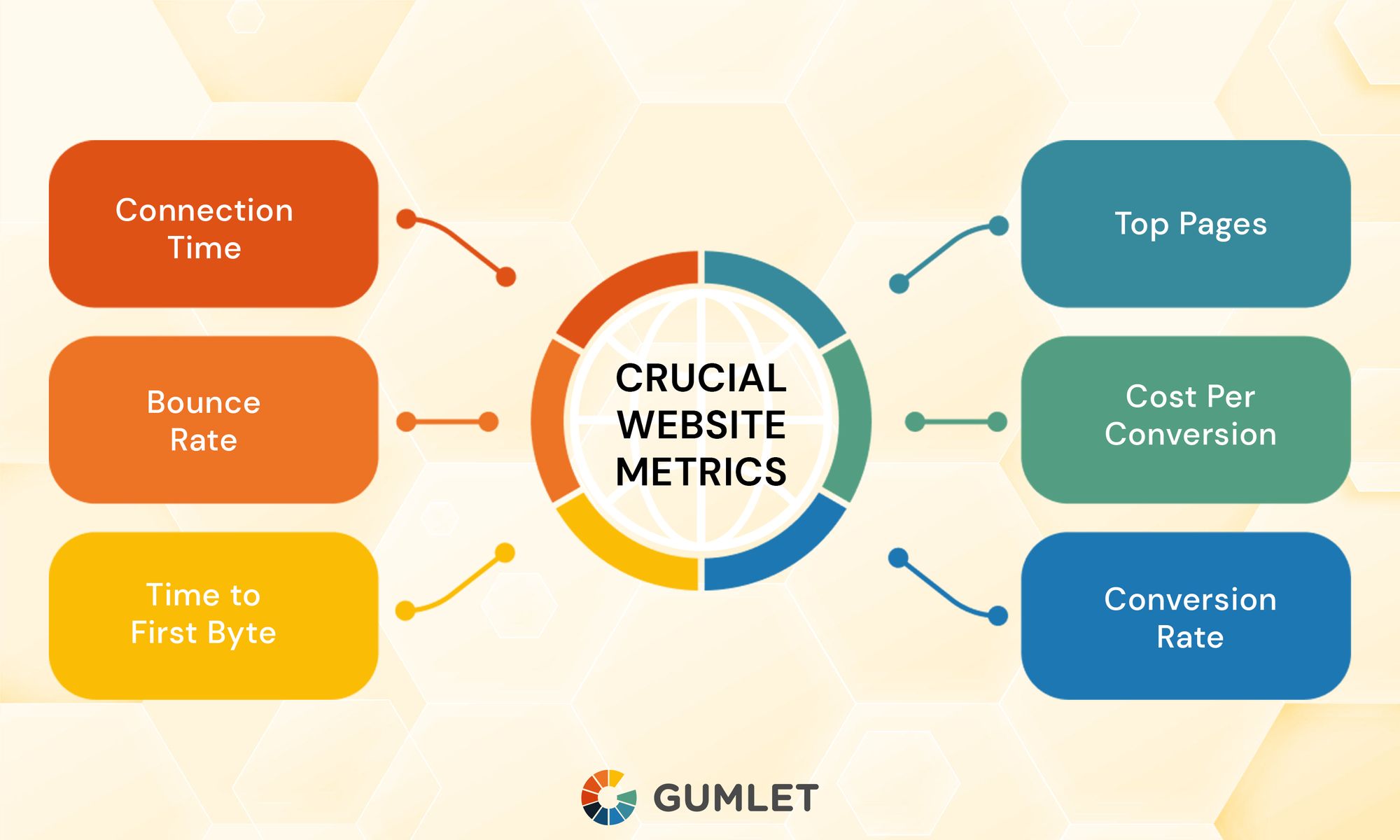If you own a website, the term 'website metrics' might have popped up somewhere. Some users might be intimidated by the sheer presence of the word. However, the question is – should this technical jargon bother you?
In simple words, web performance metrics are nothing but numbers that track a website's statistics. For example, visitor traffic, bounce rate, top viewed pages, conversion rate are various website metrics.
To meet the demand of today's fast generation of online users, you need to read these metrics or numbers. By analyzing these stats, you can get a real-time idea of your site's performance.
This blog explains how you can use these website metrics to create and maintain your optimum business site.
What Are Website Metrics?
Website metrics are different measurements made on a website to track its performance and vital stats. These performance metrics tell you whether your website is keeping the audience intrigued.
Benefits Of Website Metrics
Apart from the assessment of the visitors, these measurements provide several advantages to a website owner.
- Determine future market strategies
- Find customer interests
- Design ad campaigns and target audience
- Provide data in real-time
- Get hidden insights over site data
Common Website Metrics
If you own a website, be sure to understand these website metrics to make the right decisions.
- Bounce rate
- Top pages
- Conversion rate
- Returning visitors
- Average time on site
- Pages per visit
- Cost per conversion
- Number of shares on social media
These metrics can help you track your company's web performance. Moreover, each tool presents a clear picture of the current status and opportunities for further improvement.
What is Performance Metrics?
Performance metrics are simply measurements that help in assessing the work of a website. Performance metrics are used to measure the behavior, activities, and performance of a business. This should be in the form of data that measures required data within a range, allowing a basis to be formed supporting the achievement of overall business goals.
Top Performance Metrics
Optimizing a website consists of various activities. For instance, by optimizing media like images and videos, your website speed can improve drastically. And users love a responsive website. Nearly 47% of users expect a webpage to load in less than 2 seconds.
Hence, site performance depends heavily on website metrics like page speed. To optimize your website, you need to pay attention to performance metrics.
Better Customer Experience
Customers define the trends in today's fast-paced world. A business with a loyal and dynamic customer base is a huge success. But how do businesses achieve this feat? You guessed it – performance metrics!
To provide a better customer experience and simplify the customer journeys, you need to understand the following aspects:
- Customer interaction with your site
- Time spent on your website
- Social media sharing frequency
- Customer lifetime value
- Returning visitors
A good website owner keeps periodic assessments of all relevant website metrics. Moreover, these metrics give an exact number of all the above aspects.
Thus, users can work on fluent site performance to provide a better customer experience by rectifying certain loopholes and making additions.
Gives Insights For Future Improvements
You cannot predict the scope of improvement without proper website metrics. By understanding technical data like cost per conversion, exit pages, and traffic sources, you can implement new systems if needed.
Let us discern this benefit with the help of an example. An e-commerce website can use performance metrics like conversion rate and top pages.
Business owners can shift a product with a high conversion rate to the front of their landing page. Similarly, they can work on promoting other products by analyzing the number of visitors.
On the other hand, online surveys can help e-commerce sites predict the mood of the public. Consequently, they can optimize website performance to lure new visitors.
DNS Lookup Time
DNS stands for domain name system. These servers query names into IP addresses. DNS lookup time is the duration that a provider takes to translate your domain name into an IP address.
Different DNS providers can have variable lookup times. You don't want your audience to wait for the site to load. Hence, analyzing DNS lookup time is one of the most vital website metrics.

How To Improve DNS Lookup Time?
You can improve, i.e., reduce the DNS lookup time by reducing the number of hostnames that generate your website page. For this purpose, you need to assess whether you need all external resources to utilize the DNS lookup.
Also, by using the DNS cache, your site can load exceedingly swiftly without needing a DNS lookup. You can use a tool like WebPageTest to evaluate such website metrics and take necessary actions.
Time To First Byte
One of the most elementary performance metrics is the TTFB (Time to first byte). This parameter is simply a measure of the time taken by a file to reach the end-user.
Depending on your user's location, the TTFB varies indefinitely. For instance, a user in South Africa will have a different experience than the ones sitting in India.
An average TTFB is less than 600 ms. However, the ideal value hovers around the 200 ms mark. Your aim to improve site performance must be to keep TTFB constant for different locations.
How To Improve Time To First Byte?
There are many ways to improve TTFB. Some common solutions are:
- Invest in good web hosting
- Use a reliable CDN
- Make use of caching
- Optimize the SSL connection
Time To Interact
You need to evaluate website metrics that relate to website speed. Time to interact (TTI) defines the point at which users can interact with a web page after rendering.
This term can have a significant impact on user experience. A low TTI can help improve customer satisfaction.
For instance, e-commerce website audiences need fast responses to carry different operations. These operations can include adding a product, hitting the buy button, and paying online.
How To Improve Time To Interact?
By optimizing time to interact (TTI), you can optimize the website performance. Following are two common methods to improve TTI:
- Minimize code and use the concept of code splitting
- Use preload
Time To Title
The 'time to title' is the first impression of your website. This measurement is one of the crucial website metrics for a successful online presence.
Simply put, 'time to title' is the time taken for your website title to appear on the browser tab. Of course, this time starts from the moment the user types your website.
What is the significance? There is a rise in 27% conversion rate even with an improvement of website speed by 1 second! Thus, all these website metrics are highly lucrative.
Time To Start Render
This metric is the point when something appears on your screen. This 'something' can be a logo, a color, or any content.
With short render times, the user feels comfortable. Good websites have a duration of around 1 second for render time.
These website metrics are crucial to keeping customer engagement high. Users feel comfortable knowing something happens behind the computer screen after clicking.
Bounce Rates
Bounce rates are crucial website metrics that tell companies the number of users leaving their website immediately.
You should ideally aim for low bounce rates. By evaluating this performance metric, the website owners can take measures like:
- Improve the quality of content
- Rectify page loading speed
- Good web design
- SEO-rich content
High engagement times are conducive for any business and are proof of fluent site performance.
Error Rates
The error rate is the percentage value of issues with the total number of issued requests. High error rates are detrimental to the site performance and need immediate attention.
Website owners can use reliable media analysis tools like the Gumlet website analyzer. This analyzer gives insights of image and video content.
Conversion Rate
A conversion rate is directly proportional to your website sales. This rate is one of the most important website metrics to determine your site's success.
In simple words, conversion rate tells you about the number of visitors that convert into customers. Factors affecting conversion rate include, but aren't limited to:
- Your website's UX
- Speed of your website
- Relevant and useful content
- An appropriate call to action
The go-to-market platform like Dealfront can help you attract the right website visitors, ultimately leading to a higher conversion rate.
Page Speed And Load Time
As the name suggests, these performance metrics are self-explanatory. Page speed is the pace at which your website content loads in front of the end-user.
Load time is the duration required for loading webpage elements like images, HTML, CSS, and third-party resources.
You can check these website metrics by using a tool like Google PageSpeed Insights. For more detailed reports, gumlet's webpage analyzer uses Google's lighthouse engine. You can easily optimize the media files and improve your page speed and load time.
Other Important Metrics
The above website metrics can help you make the right decisions for optimizing your website. As you can observe, most of the performance metrics relate to webpage speed improvement.
Hence, your website must remain swift and crisp to attract and retain customers. Apart from working on the above metrics, you also need to pay attention to some overlooked ones.
Overall Website Weight
Website weight is the volume of your site that impacts your overall web performance. This term is one of the most important core web vitals.
One of the most common reasons for a heavy website is the excess data looming on your site. On average, a desktop webpage can weigh around 2000 Kb. The mobile page, on the other hand, can weigh around 1800 Kb.
To optimize website performance and decrease the website weight, you need to:
- Optimize images
- Use CDN
- Reduce extra fonts
- Remove unused plugins
FCP
First, contentful paint measures the duration from when the page starts loading to the portion of content rendering . It tells developers about the loading time of any part of the webpage content.
If you measure FCP to determine site performance, aim for a time under 2 seconds. You can use PageSpeed Insights, Search console, and JavaScript Library to measure FCP.
Requests Per Second
Finally, one of the most vital website metrics is RPS or QPS. This metric is the amount of traffic that a search engine receives in one second.
If you receive more RPS, your site is enjoying high user traffic. Hence, aiming to increase your website's RPS is conducive for your business. These website metrics can form an integral part of your marketing campaign.
Endnotes
A fast, responsive, and attractive website is a sign of efficient optimization. However, to carry out such a process, it is vital to analyze website metrics. A common way to improve your site performance is by increasing page speed.
Remember, online customer retention is all about a healthy webpage. Moreover, knowledge about core website metrics can help you plan your website optimization wisely.




